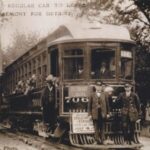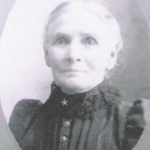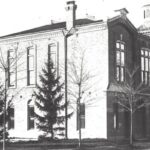The Oliver Bristol Family – The Beginnings – Coming to Almont
- Jim Wade
- April 1, 2020
- 7 Min Read
Oliver Bristol was born on January 27, 1787 in Killingworth, Middlesex County, Connecticut to Bezaleel Bristol III (1749-1828) and Mary Redfield Bristol (1755-1838). Oliver was their seventh children and fourth son of a total of eleven children; six boys and five girls. Bezaleel III was a Revolutionary War patriot and local Justice-of-the-Peace. Mary Redfield’s third great-grandparents were John Alden and Priscilla Mullins Alden, who arrived in America on December 21, 1620 abroad the Mayflower.
Oliver grew up working on the family farm with his brothers. At an unknown date prior to 1812, Oliver and his older brother Bezaleel IV (1782-1859) moved to the western New York county of Monroe (previously part of Genesee County) near Churchville. Monroe County is on Lake Ontario and its largest city is Rochester.
Oliver and Bezaleel constructed a saw mill and grist mill near the town of Churchville which is just north of Riga. The mills provided Oliver and Bezaleel with a comfortable living.
Oliver married Eunice Adams, who was the daughter of Thomas Adams (1759-1844) and Mary White Adams (1768-1843). The date of their marriage is not known but it probably occurred in Riga, New York about 1817 or 1818. Eunice was born on January 17, 1797 in Peru, Berkshire MA.
Eunice died on August 16, 1820. It is likely that Eunice died in child birth. An infant son, Henry, died in October 1820. Eunice was buried in the Riga Cemetery in Riga. Henry’s burial location is not known.
Oliver’s second marriage was to Abeneth Smith probably in Riga. They were probably married in 1821. They had three children – a boy and two girls. Only the identity of the oldest child, daughter Mary is known. Mary was born on April 28, 1822 in Riga. All three children came to Almont with Oliver.
Oliver and Bezaleel had prospered for many years until they underwrote several ventures which failed. About this time, 1828, they learned that their father was in poor health. They traveled back to Killingworth but Bezaleel III had just passed away. They did make it in time for the funeral.
According to family history, probably in 1829, Oliver and Bezaleel came to Michigan to trap beaver. They returned home with pelts worth about $1,000. Unfortunately, this did not relieve the financial pressure they were under due to the failed loans. The brother decided to move their families to Michigan.
According to family history, the brothers came to Almont without their families in 1830. They selected properties and built log cabins in which to stay. They logged off a portion of these properties and hauled the logs to the saw mill in Romeo to sell the logs. Oliver on October 6, 1830 had enough money ($100.00) to buy his 80 acre parcel in Section 27, on the east side of Van Dyke and just south of the Clinton River.. He went to the Territorial Land Office in Detroit and purchased the property. This makes Oliver the second person to buy land in Almont and stay to improve the property.
Oliver spent the winter in Michigan cutting down more trees. However, when he took them to the saw mill he didn’t just sell them. He would take logs to the mill and return with milled lumber. By spring, he had enough lumber to build the first wood frame structure in Almont and Lapeer County. Oliver’s frame home still exists. It is at 805 S. Main Street and has been extensively remodeled.
Once he completed the frame house, he and Bezaleel returned to Riga and they brought their families back to Almont. They arrived in Almont on May 22, 1831. They brought with them their farm implements and livestock.
About six months after breaking his leg, to get around, Oliver was still using crutches. He found that a bear had killed one of his milk cows. Oliver knew he had to dispose of the bear. He went hunting, found the bear, shot it but only wounded it. As the bear approached him, he rapidly reloaded and shot, killing the bear.
In 1832, a “Road Bee” was called to build Howland Road from Van Dyke to Tubsprings. The inducement to get men to participate was a keg of spirits. Someone tapped the keg and replaced the spirits with water. After completing the construction of the road, the men returned to enjoy their reward. The spirits were not having the desired effect. A close inspection of the keg found the tampering.
It is assumed that the man who tapped the keg confessed to his crime and shared the siphoned whiskey with the men who were there. The men had a good laugh and joked that they should call this place “Tapshire”. Newcomer, Philip Frisbie was the person who suggested the name. Up to that time, the township as a government entity did not exist and there was no name for this place.
Though the name Tapshire never had any official sanction, it was used for a period of time by those that helped construct the road. It was used often enough and long enough that other nearby county histories referred to Almont as Tapshire. Old time Almonters, those who helped build the road, were still referring to the township as “Tapshire” into the 1880’s.
On March 7, 1834 a meeting was held at Daniel Black’s Tavern to elect officers for the Township. Originally, the Township consisted of what are now Almont and Imlay Townships and the southern portion of Goodland Township. The Territorial Governor had appoint Ira Saunders (his homestead was south of Almont on the east side of Van Dyke between Hough Road and St. Clair Street) as Justice-of-the-Peace and he presided at the meeting.
About 13 voters were present at the meeting and there were seven offices to fill. They elected Oliver Bristol the Township’s first Supervisor and also to be Justice-of-the-Pease. Jonathan Sleeper was elected Clerk; Daniel Black became Treasurer; the Highway Commissioner was James Deneen; and Nicholas Richardson and Elisha Webster were the Assessors.
The last order of business was to choose a name for the Township. Elisha Webster suggested that they name the Township after his daughter, Mya. Mya was born on March 3, 1833 at Elisha’s homestead on the south side of Webster Road. However, almost all of the histories of Almont spell the initial name as “Mia”. I have only observed one document that spelled the name as “Mya”.
In December 1834 (after only nine months) the name was changed. On January 20, 1835, at the territorial level, the name “Mia” was officially changed to “Bristol” in honor of the township’s first supervisor, Oliver Bristol. There is no known reason for the change of name from “Mia” to “Bristol In 1845, Postmaster James H. Andrus requested a public meeting about the name of the village. With multiple villages called “Newburg” and multiple “Bristol Townships”, the mail was constantly being misdirected and delayed. At a meeting on December 15, 1845 in the school house, the decision was made to change the township’s name to Almont. James Thomson suggested the name as a variation of the name of Mexican diplomat Juan Almont.
Less than two weeks after the meeting to change the township’s name to Almont, Abeneth Smith Bristol died on December 27, 1845. She was buried in the Goodrich Cemetery located on Kidder Road south of Bordman Road.
Oliver married for a third time, Almira King Fox on June 11, 1846 in Lapeer County, probably in Almont. Almira was born on August 24, 1798 in Darien, Genesee County, New York to Amasa King (1770-1813) and Elsa Edmunds King (1775-1814). About 1816, she married Milton Fox in New York.
On September 25, 1834, Milton bought property in Section 20 of Bristol (Almont) Township.
Milton Fox died on September 18, 1844 in Almont. He was buried in Ferguson Cemetery.
Oliver Bristol died on December 12, 1854. He was buried next to Abeneth in Goodrich Cemetery in Bruce Township. Almira would survive for another 38 years before she died on January 10, 1892 in Almont. She was buried next to Milton in the Ferguson Cemetery.




